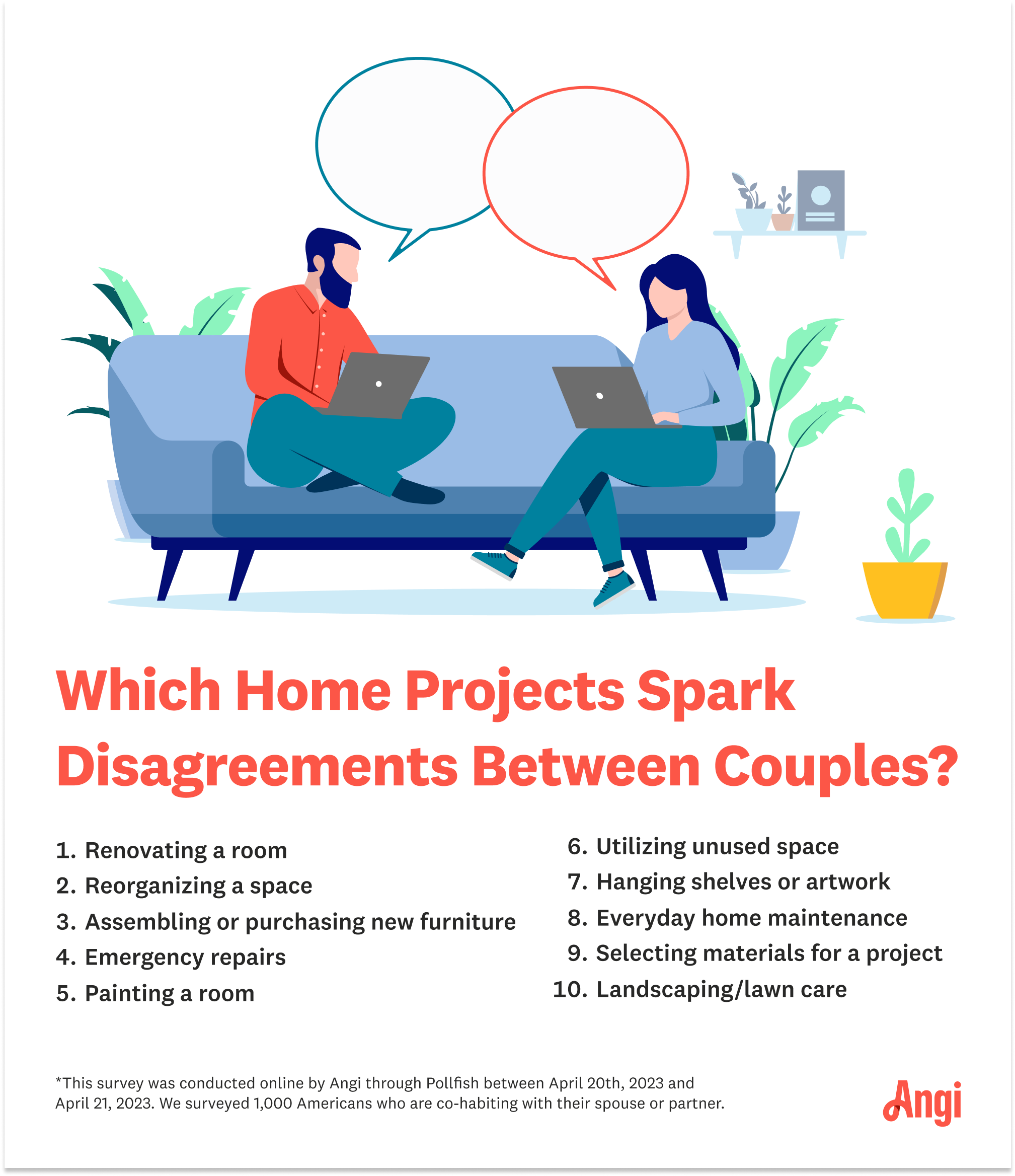What Home Projects Strengthen a Relationship?
There are some projects worth doing together and some projects worth doing solo


When tackling home projects, do you like to forge on yourself or take your time and do the project with your partner? The idea of tackling home improvement projects with your partner might elicit feelings of togetherness and closeness but don’t be alarmed if you also feel uneasiness or apprehension.
To prove our point, we surveyed 1,000 Americans cohabitating with a partner or spouse to find out how they approach DIY projects, manage spousal stress, and choose low-risk improvements. Let’s take a look at how American couples take on home improvement projects.

How Couples Feel About Home Improvement Projects
In a survey of 1,000 Americans cohabitating with a partner or spouse, 90% agree they love living with their partner, and less than 5% share that a project ended their relationship. In addition, nearly 84% found that home improvement projects were a good test of their relationship, made them appreciate and love their partner more, or helped them decide on the relationship’s trajectory.
So what does this mean for couples? Home improvement projects can be stressful, but in most cases, these hands-on, shared activities can help couples learn from each other and strengthen their bond. When thinking about the projects that cause the most stress and disagreements, a few that outrank others. In fact, survey participants ranked 10 projects from most likely to cause an argument to least. The highest stressors were:
Renovating a room or whole house
Reorganizing a space
Purchasing, assembling, or selecting new furniture
On the opposite side, these projects were ranked as being the least stress-inducing projects for couples to tackle together:
Everyday home maintenance
Selecting appliances or materials for a project
Landscaping and lawn care
Home Improvement Projects to Tackle Together
There are several low-risk home projects you and your significant other can complete together without wanting to run opposite ways. These home improvement activities can bring you together to share in the experience and, hopefully, share some laughs along the way.
Add Color To Your Walls
For a low-stress project that can make a big impact on your home, consider teaming up with your partner to paint your home (or a single room). The average cost to paint a room is $1,100 if you hire professional interior painters. But, if you have a little patience and know-how, you and your partner can paint a room for about $150, and more importantly, you can bond while doing it.
Take a trip to the hardware store to pick up supplies like brushes, rollers, and tarps, and choose a calming paint color that you both love. Make this a fun DIY project experience by taking your time with each coat and share a laugh if you “accidentally” get a few drops of paint on each other. But make sure your furniture is covered first! Don’t forget to clean your paint rollers when you're done so you can use them again to paint another room.
Spruce Up Your Lawn
Who said that home improvement is limited to inside the home? Spend time outdoors with your partner to make your lawn look brand new. To start, you can work together to remove weeds from your lawn or plant flowers or vegetables. While these tasks might sound daunting, you can play some music while you work and have a spur-of-the-moment karaoke battle to pass the time.
Maintain Your Home
Keeping your home clean can feel like an endless chore, especially with the hustle and bustle of everyday life. But if you and your sweetie work together, you can restore your home to its sparkling glory while tackling tedious tasks faster.
Start by making a list of the major and minor cleaning improvements your home needs most. For example, if your sinks aren’t moving fast enough, it’s time to find a remedy to unclog them. Luckily, there are a few ways to unclog your drain that won’t break the bank. Even better, you and your partner can try these techniques together so that one person isn’t overwhelmed. You can apply this approach to all kinds of household chores, including cleaning the washing machine, mopping the floors, and more.
When To Hire A Pro
Unsurprisingly, the more challenging or costly the project, the higher the risk of a disagreement between you and your partner. Demanding home improvement projects can cause stress over time constraints, financial aspects, or even urgency, leading to polarizing arguments.
A whopping 76% of survey participants say that home renovation or repair projects have caused relationship issues like tension, disagreements, or arguments. Hiring a professional to help with these larger projects is crucial for project success. In fact, of the individuals surveyed, almost 61% said that hiring a pro helped to reduce potential arguments.
While it’s great to bond with your partner over easier DIY projects, there are a few high-stress improvements that you should leave to the professionals to protect your safety and sanity. Consider hiring a professional for the following types of home projects.
Adding or Fixing Plumbing
The decision to upgrade or change your home’s plumbing system might cause some stress between you and your partner, especially if it’s an emergency. Hopefully, you and your partner can land on the same page, but keep in mind that of the various aspects of home improvement projects, budgeting for home improvement projects and the cost of utilities were the top unexpected sources of disagreements amongst those surveyed, 42% and 41%, respectively.
For example, if you’re considering adding another bathroom to your home, you should hire a professional plumber or contractor to take care of this job. The cost to rough-in plumbing for a new bathroom costs around $6,500 on average. While you should determine the details of the plumbing project together, including deciding on sink, vanity, and tile types, you should leave plumbing installation or replacement to a professional plumber.
Home Renovation
If you’re considering remodeling your home, you should sit down with your partner and discuss the initial details, including a project timeline, budget, and task list. You can even make it a game by taking different colored sticky notes to mark off the sections of the house you’d like to upgrade.
Once you’ve reviewed what should be improved, check your budget to see what’s realistic. For example, the cost of a kitchen remodel is significantly less than the cost of a bathroom remodel. What can you agree on together that you can afford to renovate now? What should wait? While these questions might bring about some tension, keep adding fun elements into the discussion to keep it light and friendly.
